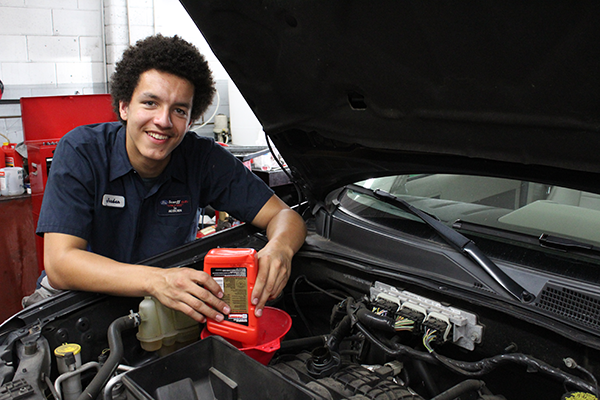The G-W Blog is proud to welcome automotive expert, educator, and G-W author Luke Thompson as a guest author for the G-W Blog. Details on his impressive background are below.
Math is part of the trade…it should be part of the training
Most CTE students take standard math courses taught by math instructors who may find it challenging to demonstrate specific applications in a field such as automotive technology and thus show why learning math is essential to career success. While these students may have received instruction in basic math previously, many of them cannot perform simple calculations or measurements and will not be motivated to improve their math skills without seeing direct applications to their areas of interest.
A common exchange between instructors and students across our systems—and especially involving students enrolled in mathematics—typically plays out like this:
Instructor: “Today we are going to learn how to divide fractions.” Or “Class, the formula for sine is the opposite side divided by the hypotenuse.”
Student: “Why do we need to learn this?” Or “I will never use this in my life.”
Statistically speaking, the students are on to something. It is unlikely that we will ever find ourselves dividing fractions into adulthood, so why do we still teach it across our school systems?
The common answer is that grade level mathematics is part of the standard curriculum, these math problems will be on the statewide comprehensive exams, and this math concept is required in order to learn even more math concepts that are increasingly difficult.
While these are all valid responses, they will likely not gain cheerful acceptance from a high school junior or technical college student.
Let’s change lanes for a minute and talk about the most common feedback I have heard from service managers, technical recruiters, maintenance managers, as well as other instructors and educational professionals. A common sentiment that I often hear sounds something like this. “I need to hire people who can think.” Or “I can’t find people who can diagnose these difficult systems.” This even comes up in conversations as, “I really just need techs who can follow directions, analyze the situation, and make an informed, thoughtful decision.”
I think it's time for a reframe.
I am referring to a concept I learned about in Scott Adams’ book, Reframe your Brain. Scott is the widely known creator of the Dilbert comics, and he has also written several books that I recommend you consider adding to your reading list.
 We must reframe the way we explain to our students why and what they are learning. Students in our technical trades classes are learning to think. They are learning to solve problems. They are learning to perform the scientific method of hypothesis: testing, analyzing, deciding. In our classrooms and shops, learning situations should be thinking situations, and we need to ensure we foster a place where we as instructors push our students to think problems through for themselves.
We must reframe the way we explain to our students why and what they are learning. Students in our technical trades classes are learning to think. They are learning to solve problems. They are learning to perform the scientific method of hypothesis: testing, analyzing, deciding. In our classrooms and shops, learning situations should be thinking situations, and we need to ensure we foster a place where we as instructors push our students to think problems through for themselves.
What can we do as instructors to nurture these vital skills?
- Guide students to solve their own problems by asking “why do you think?” or “how is that?” type questions to deepen their thinking.
- Provide relevant, real-world examples that can be directly applied to the technical role or training goals.
- Provide practice examples that promote diagnostic thought on a regular basis.
As educators in the trades, our role requires a reframe, a new way of making students learn to think, to diagnose and solve problems, and to make thoughtful, informed decisions.
______________________________________________________________________
As an educator and an author, I am keenly aware of the importance of learning to think and have found many ways to cultivate this important skill in students. If you’re interested in resources that take this approach, take a preview of two of my books that incorporate real-world examples and practice problems to build math skills.
Math for Automotive Technicians contains more than 100 case study examples that link relevant automotive scenarios to arithmetic and problem solving. This approach allows for a true integration of math and skilled trade instruction. Each section in Maintenance and Light Repair Technician includes diagnostic scenario questions designed to promote thought and discussion.
Luke D. Thompson, M.Ed. is author of G-W’s innovative, digital hands-on Maintenance and Light Repair product and Math for Automotive Technicians. Since early 2018, Luke has been a technical training instructor for Tesla, Inc. Previously, Luke taught for over a decade as a secondary Auto Technology teacher in Michigan and Washington. Throughout his teaching career, he achieved MLR accreditation for the schools where he taught. Luke has also served as an Evaluation Team Leader (ETL) for ASE and received the ASE Industry Education Alliance “Outstanding Instructor Award.” Luke earned his associate degree in automotive technology from Henry Ford Community College, his Bachelor's Degree in secondary CTE from Wayne State, and his Master’s Degree in Curriculum and Instruction from the University of Washington. Luke also holds various ASE certificates including Master Certified Automobile Technician and Hybrid/Electric Vehicle Specialist. Prior to his teaching career, Luke worked as a Prototype Technician at Ford Motor Company’s Research & Development Division in Dearborn, Michigan.





